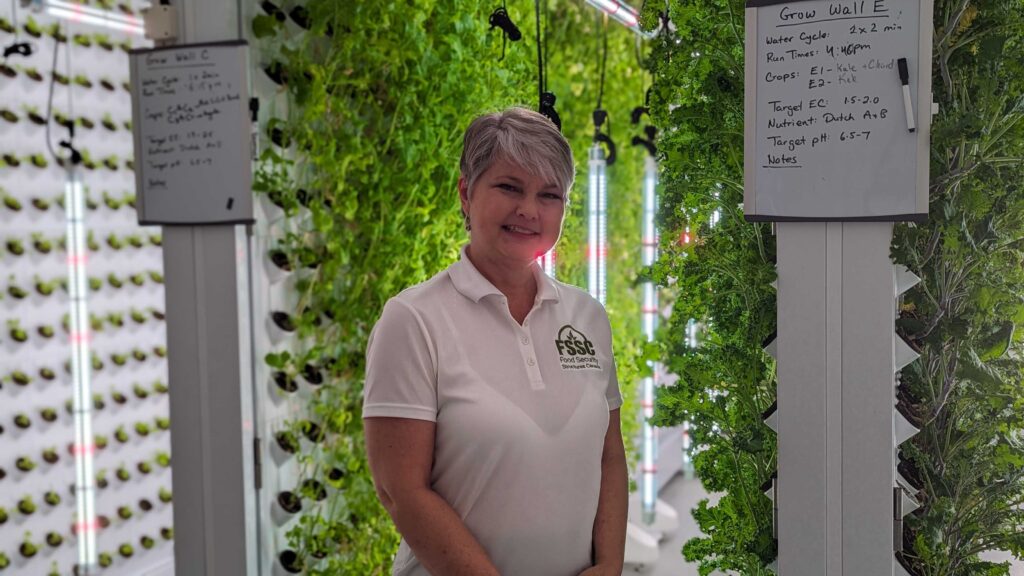LONDON, ON – Climate change and severe weather are the primary challenges facing year-round berry production in Canada. Food Security Structures Canada and Western University have devised a food security solution to address these global threats by developing a net zero energy farm, which produces berries year-round.
Currently in its first full year of operation at the Environmental Sciences Western Field Station, the project combines photovoltaic solar arrays with an Agrotunnel, which is a climate resistant, moveable structure that grows food in a high-density growing system.
“Our growing system is a hybrid of aeroponic (growing plants in the air) and hydroponic (growing plants in water) that allows plants to absorb water and nutrients on a set schedule while also allowing time between cycles allowing root oxygenation,” said Greg Whiteside, Chief Technology Officer for Food Security Structures Canada. “Combining this style of growing with our proprietary Better Grow Lights allows us to produce high yields of diverse crops year-round using less water than traditional field-based farming or hydroponics.”
Our solution provides an extremely high-density, resilient method to obtain year-round healthy fruit and vegetables with minimum production expenses. The system is modular, scalable, and adaptable to various locations and extreme climate conditions.
Industry reports show that the largest expense for any controlled-environment agriculture system is electricity. To improve the economics and decrease or even eliminate the electricity costs, the Agrotunnel and surrounding area at the field station utilize adjustable partially transparent photovoltaic solar arrays, which were designed by Western’s Professor Joshua Pearce and his team.
“Agrivoltaics is a portmanteau of ‘agriculture’ and ‘photovoltaics,’ more commonly known as solar panels,” said Dr. Pearce, the John M. Thompson Chair in Information Technology and Innovation at Western Engineering and Ivey Business School. “While harnessing solar energy, the arrays are also used as shields to protect the outdoor plants from extreme weather, creating a microclimate to conserve water while providing all the electricity needed to run the lights, water pumps and heat pumps (used to heat and cool) the inside of the Agrotunnel.”
The strawberries, blueberries, haskaps, gooseberries, boysenberry, and other crops grown at the field station are monitored with artificial intelligence (computer vision systems) and are being tested in outdoor agrivoltaics systems under different spectral semi-transparent solar cells to find the optimal conditions for outdoor use that can be compared to the growth performance available internally.
“The density is crazy,” Dr. Pearce says. “It’s like walking into a library where every row of books is strawberries. Every week in the Agrotunnel, harvest season is upon us, and the future of Canadian farming is ripe with possibility.”
Boosting food productivity and power by optimizing the use of sunlight addresses a significant problem in Canada and around the world. If the project delivers the way it is expected to, the impact on global food security is limitless.
“Our moveable Agrotunnel, Better Grow Lights and aeroponic/hydroponic growing system, combined with Dr. Pearce’s unique agrivoltaics system, creates an energy efficient, climate controlled growing space that can handle severe climate,” said Parker. “This project addresses food insecurity by empowering individuals and communities to grow their own food locally, year-round, regardless of climate or location.”
The Agrotunnel provided by Food Security Structures Canada and the agrivoltaic farm are supported in part by a $1 million grant from the Weston Family Foundation through the Homegrown Innovation Challenge (https://homegrownchallenge.ca/).

Launched in 2022 by the Weston Family Foundation, the Homegrown Innovation Challenge awarded $1 million each to 11 research teams to develop ideas for extending the growing season of berries. Each team only has 18 months to build and test its proof-of-concept ideas before the next phase of the Challenge, which will see this group of eleven reduced to four teams.
“At the heart of this competition lies the belief that the fusion of collaboration and broad expertise is the key to solving complex challenges in agriculture,” said Garfield Mitchell, Weston Family Foundation chair. “Our grantees bring out-of-the-box, yet achievable, ideas to the table, and we are excited to see the innovations that arise from their shared passion and collaboration.”
About Food Security Structures Canada:
Food Security Structures Canada is a London-based ag-tech business specializing in designing and providing controlled-environment agricultural structures, growing systems, and training. Working in Canada and around the world, FSSC strives to help address food insecurity by focusing on hyper-local food production year-round in rural, remote, and urban areas.
About Western University:
Western University delivers an academic experience second to none. Since 1878, Western has combined academic excellence with life-long opportunities for intellectual, social and cultural growth in order to better serve communities. Western’s research excellence expands knowledge and drives discovery with realworld application. Western attracts individuals with a broad worldview, seeking to study, influence and lead in the international community.
For more information contact:
Kim Parker
President and CEO
Food Security Structures Canada
Phone: 519-857-2707
Email: kim@foodsecuritystructures.ca
Website: www.foodsecuritystructures.ca